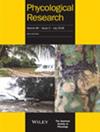微藻产氢过程中hyd和fdx的生物信息学分析及相对表达
IF 1
4区 生物学
Q2 MARINE & FRESHWATER BIOLOGY
引用次数: 0
摘要
微藻已被定位为生产新能源(生物燃料和生物氢)的优秀模式。在这些生物模型中,一些研究的目的是了解铁氧还蛋白(FDX)和氢化酶(HYD)酶是否参与藻类产生不同浓度的分子氢(H2)。迄今为止,对藻类H2进化过程中这两种酶的转录调控知之甚少。在本研究中,我们评估了三种微藻(小球藻、斜角藻和莱茵衣藻)在缺氧培养条件下(Fe存在下)和12:24和24:24 h暗/光循环中H2进化过程中hdy和fdx基因的相对表达。我们还检测到了酶的结构差异。三维建模表明,HYD和FDX的三维结构在大多数藻类属中都是保守的,根据蛋白质的aa特征进行分组的结果显示出两种分组趋势:一种是根据藻类的系统发育分类,另一种是根据物种特异性酶的特征进行分组,并且分组可能更多地受到藻类产生H2的能力的影响。这三种微藻在补铁条件下,在24小时:24小时暗:光照条件下H2积累值达到最大值(C. vulgaris为4.2±0.12 mL L−1,S. obliquus为3.9±0.10 mL L−1,C. reinhardtii为4.5±0.10 mL L−1),hyd和fdx基因的全球相对表达量在光照前1小时达到最高,这表明这两种酶在H2产生开始时同时表达。在这些藻类中,hyd和fdx基因的表达行为在种间是相似的。更好地了解这两种酶的伴随调控可以为未来使用这两种酶来提高微藻的H2产量奠定基础。本文章由计算机程序翻译,如有差异,请以英文原文为准。
Bioinformatic analysis and relative expression of hyd and fdx during H2 production in microalgae
Microalgae have been positioned as excellent models for producing new sources of energy (biofuels and biohydrogen). Some investigations in these biological models have been directed to know if the enzymes ferredoxin (FDX) and hydrogenase (HYD) are involved in the algae producing different concentrations of molecular hydrogen (H2). To date, little is known about the concomitant transcriptional regulation of both enzymes during H2 evolution in algae. In this research, we evaluated the relative expression of hdy and fdx genes during the evolution of H2 in three microalgae (Chlorella vulgaris, Scenedesmus obliquus, and Chlamydomonas reinhardtii) in N‐deprived anaerobic cultures in the presence of Fe, and 12:24 and 24:24 h dark:light cycles. We also detected structural differences in the enzymes. The 3D modeling indicated that the 3D structure of HYD and FDX are conserved in most algal genera, and the results of our grouping according to the aa characteristics of the proteins showed two grouping trends: One, according to the algae's phylogenetic classification, and another one according to the species‐specific enzyme's characteristics, and the grouping could perhaps be more influenced by the algae's ability to produce H2. The three microalgae species reached maximum H2 accumulation values in 24h:24 h dark:light conditions in Fe‐supplemented media (4.2 ± 0.12 mL L−1 in C. vulgaris, 3.9 ± 0.10 mL L−1 in S. obliquus, and 4.5 ± 0.10 mL L−1 in C. reinhardtii), and the highest global relative expression of hyd and fdx genes was reached during the first hour of exposure to light, which suggests concomitant expression of both enzymes at the beginning of H2 production. The behavior of the expression of the hyd and fdx genes in these algal species proved to be similar between species. A better understanding of the concomitant regulation of both enzymes could lay the groundwork for the future use of both enzymes to improve H2 yields in microalgae.
求助全文
通过发布文献求助,成功后即可免费获取论文全文。
去求助
来源期刊

Phycological Research
生物-海洋与淡水生物学
CiteScore
3.60
自引率
13.30%
发文量
33
审稿时长
>12 weeks
期刊介绍:
Phycological Research is published by the Japanese Society of Phycology and complements the Japanese Journal of Phycology. The Journal publishes international, basic or applied, peer-reviewed research dealing with all aspects of phycology including ecology, taxonomy and phylogeny, evolution, genetics, molecular biology, biochemistry, cell biology, morphology, physiology, new techniques to facilitate the international exchange of results. All articles are peer-reviewed by at least two researchers expert in the filed of the submitted paper. Phycological Research has been credited by the International Association for Plant Taxonomy for the purpose of registration of new non-vascular plant names (including fossils).
 求助内容:
求助内容: 应助结果提醒方式:
应助结果提醒方式:


